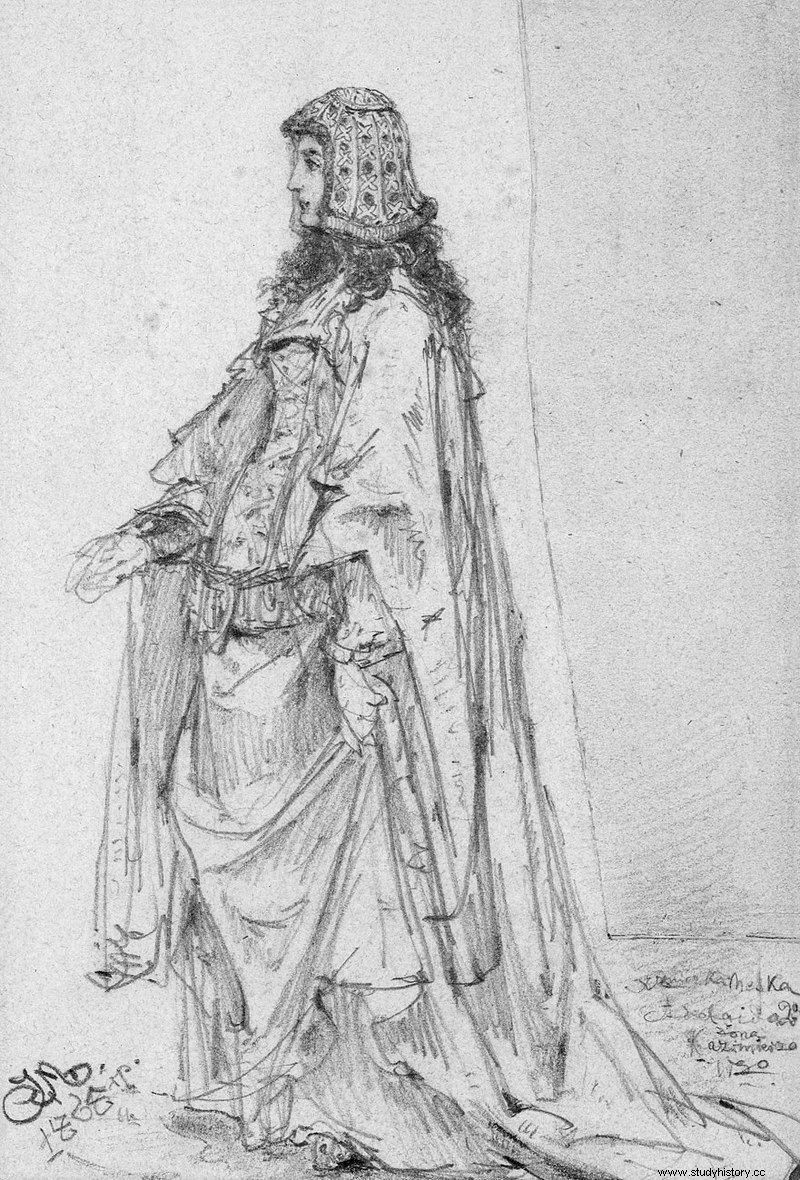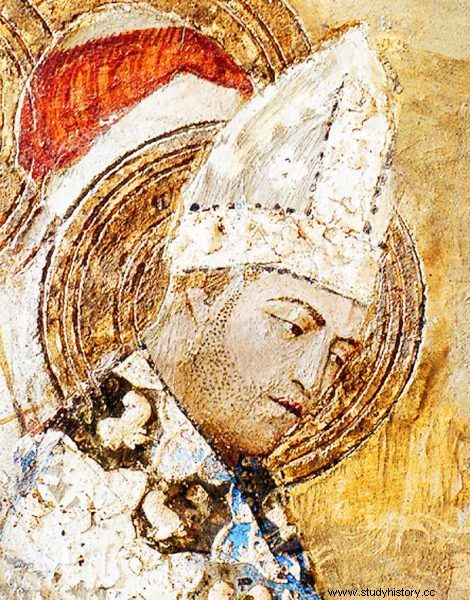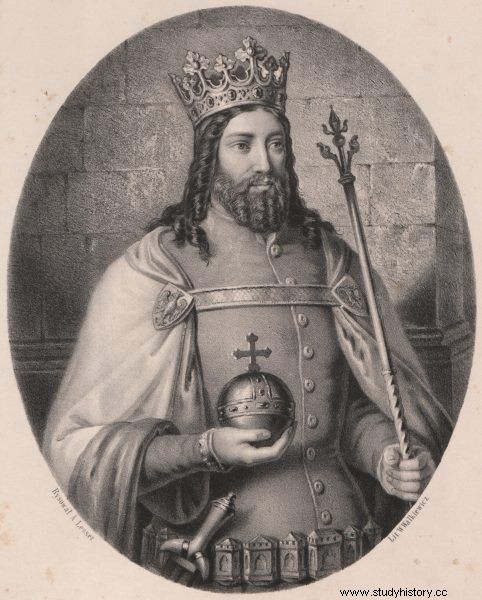King Casimir the Great did not play the role of a knight in shining armor. On the contrary. It was he who locked his unwanted and unloved wife in a fortress, trying to break her will and force her to divorce. The hart of Adelaide of Hesse's spirit, however, turned out to be much greater than anyone could have suspected.
Kazimierz, commonly known as an incorrigible babiarz, who saw in women mainly as a source of temporary, casual entertainment, got in 1341 a wife who was not very pretty, overly read and, as he would probably put it, so barked out that it was difficult for him to bear her. Finally, the icing on the cake - the bride did not give him any political benefits, even trivial. I have already written about the backstage of the Polish king's second marriage in other articles. But what was the relationship of Kazimierz the Great and Adelaide Heska like?
The Polish monarch hoped at least that the new wife would give him sons. Until now, he had no legal descendant and there was no joking fear of the end of the dynasty. However, the fundamental difference between the deceased Małgorzata Luksemburska - a woman who under an earlier agreement was to become Kazimierz's wife, but unexpectedly died - and Adelaide, substituted in her place by the cunning Luxembourgs who ruled the Czech Republic. The former was already married and gave birth to one son. It was to be expected that she would be able to conceive again without any problems. Adelaide, meanwhile, turned out to be completely sterile.
The marital duty "perfectly kept"
How was the marriage of the royal couple initially? Depends who you ask. Years later, in letters sent to the Holy See, Adelaide would emphasize that on her part "the marriage obligation" was constantly "especially perfectly preserved." Kazimierz will express the exact opposite view. And he will complain that the quarrels in the marriage arose because the queen did not want to be in his alcove.

Adelajda Heska on a sketch by Jan Matejko.
Easier to believe her than him. There is ample evidence that the spouses' relationship was correct for at least the first few years. Kazimierz was still hoping that a new life would awaken in Adelaide's womb. He knew that he himself was not sterile. His lovers bore him at least two sons:Niemierzę and Jan. As bastards, however, the boys had no rights to the throne. The king needed a legal descendant and was getting more and more impatient.
He had complaints not to fate, but to his wife, unable to meet his expectations. "Kazimierz lived with that Adelaide for fifteen years, showing disgust and contempt for her," emphasized Jan Długosz. Relationships broke down, although at least the appearance was kept for a long time.
Back in 1350 (i.e. nine years after the wedding), Kazimierz asked Pope Clement VI for a special indulgence not only for himself, but also for the queen. He also asked that the holy father give Adelaide the right to choose his own confessors. This particular privilege could be much more useful to him. Because the sin of adultery came extremely easily to Piast.

Fresco depicting Pope Clement VI
"He had intercourse with concubines whose swarms he kept"
The monarch looked greedily at mansions, servants and noblewomen who were visiting the court. If you believe Długosz, he did not have one or several lovers - he had dozens of them. "Having pushed aside" his wife "with contempt, he had intercourse with concubines whom he held swarms in Opoczno, Czchów, Krzeczów and other places; he has created a kind of prostitute houses here. ”
According to the chronicler, the scale of the king's debauchery was even the disgusted pope, who had more than one hideous sin on his own conscience. Clement VI allegedly threatened Kazimierz with the consequences and recommended that "having separated the harlots, he would not order a marriage bed any longer". Similar exhortations were also made by a very talkative priest, Marcin Baryczka. He was the vicar of the Krakow cathedral and spread stories about the disgusting life of the king throughout the city, calling for him, "rejecting the seduction of women, to live in temperance and in marriage."
Kazimierz could not directly tell Pope what he thought. The Polish king was probably forced to confess and promise an improvement. He took all his anger out on the impudent and defenseless vicar. On the royal order, the priest was imprisoned and "drowned innocently in the Vistula River the next night".
A bird in a golden cage
Adelaide had every reason to fear that she would suffer a similar fate as well. After all, it was said that one of Kazimierz's predecessors, Przemysł II, who ruled at the end of the 13th century, had his sterile wife, Ludgarda, strangled, and thus useless for his political plans. Some even claimed that the ruler himself tightened his hands around the victim's neck, taking her last breath.
Adelaide's relationship with Kazimierz grew increasingly tense. The queen did begin to avoid her husband. She was looking for any job, she tried to be of help to the state and to vent her own ambitions. She supported art, maybe even meddled with political matters. However, each of her initiatives only deepened Kazimierz's rage.
The monarch limited the size of his wife's court, and probably also took away some of the funds allocated for her maintenance. Finally, in 1355, he decided he did not want to see Adelaide any more. He ordered his wife to be placed under house arrest.

Casimir the Great in a painting by M. Bacciarelli.
"The Queen stayed in the Żarnowiec castle, like a mean slave and exile, although all her wealth was properly and generously supplied to her" - explained Jan Długosz. If Kazimierz ever looked into that golden cage, it was only to demand a divorce from Adelaide.
He was not in good enough relations with the papacy to unilaterally obtain the annulment of his marriage, and the fact that his sister, Queen Elizabeth of Hungary, had just had a bitter conflict with the Holy Father (who had a finger in the murder of her son) only made it difficult for him to negotiate with the curia. If he wanted to legally get rid of Adelaide and remarry, he needed her permission. But the queen, locked in the tower, stubbornly refused to approve the separation.
"The king banished me, though I was not at fault in any way"
The king kept his wife locked up for almost two years. Finally, unable to break her will, he decided to break the vow even without the approval of the other party and without the Pope's blessing. In mid-September 1356, he either ordered Adelaide to leave or made her life so unbearable that she made the decision to leave herself.

Casimir the Great as imagined by A. Lesser.
The ruler returned to her father, to Hesse, where at the side of Henryk Żelazny, who was aged and much calmer than years ago, she immediately spread her wings. The energy that Kazimierz had been stifling in her for a decade and a half, she used up, taking on some imperious duties, but also - immediately hitting the Holy Father. "Following the whispers of the evil spirit, or perhaps on the advice of someone else, the king banished me, although I was not at fault in anything," Adelaide complained to the Pope.
Kazimierz hoped that by throwing out his wife, he would get rid of the trouble. His real problems, however, were yet to begin. The English playwright William Congreve rightly wrote that "hell knows no fury like a scorned woman." As long as she was alive, Adelaide did not intend to let go of the faithless one who had humiliated and abused her. And it turned out that he would live for quite a long time.
Selected bibliography:
The article was based on materials collected by the author during the work on the book "Ladies of the Polish Empire. The Women Who Built a Power ". Some of these items are shown below. Full bibliography in the book.
- J. Bieniak, "Litterati" lay people in the Warsaw trial of 1339 [in:] Cultus et cognitio:studies in the history of middle-class culture , Warsaw 1976.
- Kiryk F., The Great King and His Successor , National Publishing Agency 1992.
- Klápště J., The Czech Lands in Medieval Transformation , Brill, Leiden – Boston 2012.
- Kurtyka J., The reborn kingdom. The monarchy of Władysław Łokietek and Casimir the Great in the light of more recent research , Societas Vistulana, Krakow 2001.
- Wyrozumski J., Casimir the Great , Ossolineum, Wrocław 2004.
- Singer, Blindness and Therapy in Late Medieval French and Italian Poetry , Boydell &Brewer, Woodbridge 2011.
- Śliwiński B., Chronicle indiscretions, or the private life of the Piasts , Marpress, Gdańsk 2004.
- Śliwiński J., The marriages of Casimir the Great. A study in the field of morality and ethics of the royal court in Poland in the 14th century , Pedagogical University in Olsztyn, Olsztyn 1987.
- Świeżawski E.S., Esterka and other women of Casimir the Great [in:] the same, Outlines of critical research on history, historiography and mythology , vol. 3, Warsaw 1894.
- Weygand Z., The Blind in French Society from the Middle Ages to the Century of Louis Braille , Stanford University Press, Stanford 2009.
